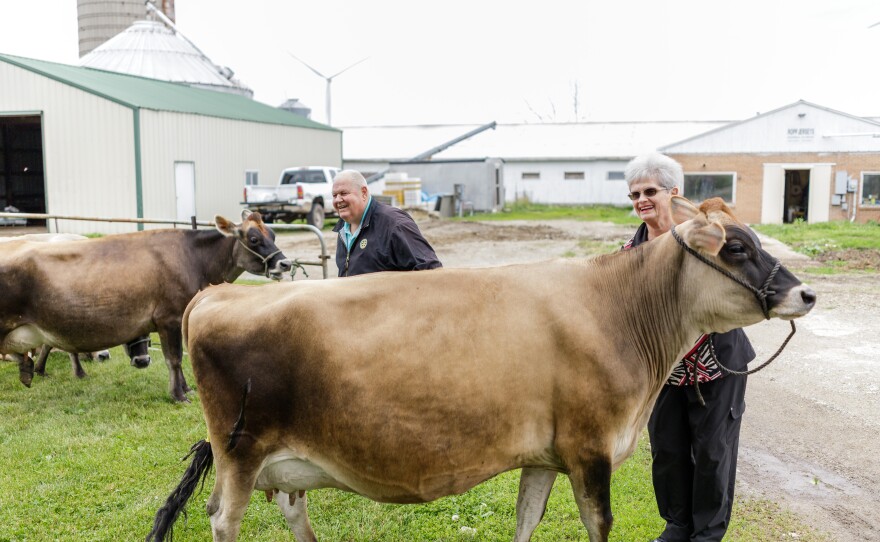In the 90 days since Gov. JB Pritzker appointed her head of the Illinois Department of Natural Resources, Colleen Callahan said she’s gained an understanding of just how big an impact the state’s two-year budget impasse had on the agency.
Callahan spoke with GLT at a meeting of the Normal Rotary Club at the Ropp Dairy Farm in Normal Wednesday evening.
“At one time, and before my time, the IDNR was one of the if not the most highly regarded throughout the United States,” she said. That’s in sharp contrast to what she’s heard from IDNR staff, who say that they’ve been operating in “survival mode” after suffering staff cuts and site closures.
She said in that state, “you don’t accomplish much; you’re just trying to make it through.”
Callahan compared the site superintendents at many of the facilities that fall under the IDNR’s jurisdiction to teachers who spend their own money to make sure their students have all the supplies they need.

“When people are expecting to be able to enjoy the park and there’s something that needs to be fixed or repaired, they’ll dig into their own pocket to make sure that the plumbing works in the restroom,” she said. “So to be the advocate and to defend why we need additional funding or why we need support or staffing is my role.”
Callahan said while Illinoisans are familiar with entities like the IRS, state departments of natural resources are the agencies that have the most direct contact with residents.
“Visiting a park or a museum or historic site, going fishing, using public lands for fishing, that’s very direct contact,” she said. “And if any of those are in disrepair, then that reflects on the state of our government as well.”
Today, with a state budget in place and legislation moving through the capitol, Callahan said the future of the IDNR is looking brighter.
And while it will take some time to see the kind of major improvements the state’s public lands need, she said the agency can take small steps now to make a difference. From laying down fresh gravel to a park entrance or fixing a roof at a public building, “Those are things that you can notice, and those are things that we do have funding to do,” Callahan said.
Callahan said she’s seen evidence that the department has Pritzker’s support in those efforts. She said staff at the Illinois State Museum told her while touring the facility with Pritzker that he was the first governor to request a visit since Gov. James Thompson.
“The governor and his staff have been very attentive and are very interested in our needs and in learning more,” she said.
Some were surprised by Pritzker’s pick to lead the IDNR; Callahan is neither a scientist nor career politician as her predecessors have been. Rather, she comes to the department from the U.S. Department of Agriculture, heading up Rural Development in Illinois.
But Callahan said what benefits the state’s agricultural industry is often in the best interest of preserving the state’s natural resources.
She described a transition committee meeting with new Illinois Department of Agriculture Director John Sullivan.
“When someone would bring up in that transition committee about cover crops, isn’t that about preserving our soil? Aren’t soil and water our natural resources? So we should be working together, and John and I have begun to do that,” she said.
Breaking Barriers
Callahan is also the first woman to head up the department, though she said that was never her goal, “nor was it ever a goal of mine to be the first woman to do anything. It just sort of happened that way.”
This isn’t the first time Callahan has broken a trend of male influence; she also began her 30-year career in journalism as the only female broadcast reporter covering agriculture at the time, and went on to become the first female president of the National Association of Farm Broadcasting.
“And I didn’t want to do it to be the first. It just so happened that I was the first, and I sought the opportunity, and that station at the time was willing to take a chance, and it worked for them, and it worked for me,” she said.
But Callahan said while firsts are certainly worth noting, “they should never be the lead story about a responsibility."
Callahan said she’s looking forward to meeting with her fellow heads of departments of natural resources from other states in Ohio this August to discover other strategies that could work in Illinois.
“I have a list of questions prepared when I meet with my colleagues ... to ask what they do and how they do it, how are they structured, have they made any changes that have been noticeable as far as creating efficiencies,” she said.
That eagerness to share with others is part of her overall approach to leadership at the IDNR, which she said begins with a foundational mantra: “communicate, collaborate and connect.”
“I flunked mind-reading, so unless you tell me what I need to know, what I should know in order to make decisions about and for the agency ... I need you to share with me what you know and what you’ve experienced,” she said. “So I’ve tried to be a good listener and base my decisions on a collaborative effort.”
WGLT depends on financial support from users to bring you stories and interviews like this one. As someone who values experienced, knowledgeable, and award-winning journalists covering meaningful stories in central Illinois, please consider making a contribution.




